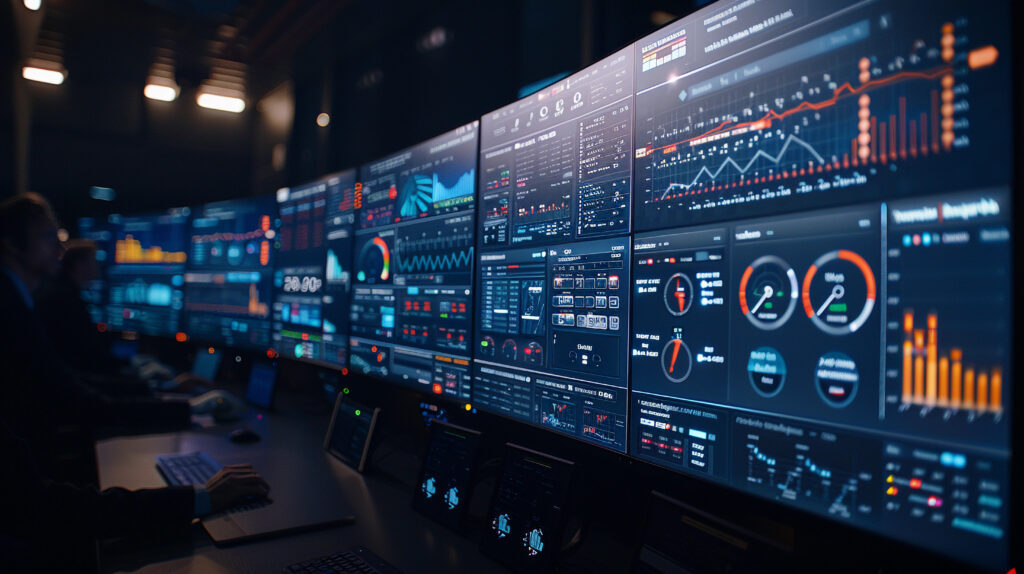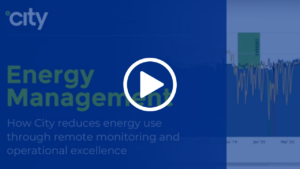
In food retail, an industry notorious for its energy consumption and tight profit margins, even a modest efficiency gain has an impact — an EPA report found that a mere 10% reduction in energy costs can boost profit margins by about 16% for the average supermarket. Beyond cost, facility managers face pressure to meet sustainability goals and regulatory standards for reducing their carbon footprint.
With new incentives (the U.S. Inflation Reduction Act earmarks $369 billion for climate initiatives) and stricter energy regulations emerging, energy management has become a critical focus for food retailers and commercial facility managers alike. This is where Energy Management Software (EMS) comes into play as a game-changer for controlling costs, improving operational efficiency, and meeting sustainability targets.
What Is Energy Management Software (EMS)?
Energy Management Software is a digital platform that tracks, analyzes, and optimizes a facility’s energy usage across systems like refrigeration, HVAC, lighting, and more. In practical terms, EMS aggregates data from sensors and meters (or building automation controls) to give facility managers real-time visibility into how energy is being consumed.
The software continuously monitors usage patterns and conditions, applies analytics, and often provides recommendations or automatic controls to improve efficiency. For example, an EMS might show a supermarket how much energy each store or asset (like a refrigerated case or HVAC unit) is using, flag abnormally high consumption, and adjust settings to reduce waste during off-peak hours.
What sets modern EMS apart is intelligence and proactivity. Erick Brown, Director of Energy at City, emphasizes that today’s EMS platforms leverage advanced analytics to go beyond basic monitoring. “Today’s EMS platforms are quite sophisticated, using real-time analytics of numerous data points, which helps us spot issues early and keep systems running efficiently,” says Erick.
In other words, the software doesn’t just report data — it actively identifies inefficiencies and predicts issues so they can be addressed preemptively. This level of insight and automation is a key differentiator of a robust EMS, enabling businesses to save energy in ways manual tracking never could.
Energy Management Systems vs. Energy Management Software
The terms “energy management system” and “energy management software” are often used interchangeably, but there is a subtle distinction.
An Energy Management System in the broad sense refers to the entire collection of hardware, software, and processes used to monitor and control energy usage in a facility.
This includes physical components like sensors, controllers, smart thermostats, and meters—essentially a network of devices working together to manage energy. In the context of building automation, this setup is sometimes referred to as an Energy Management System.
In contrast, Energy Management Software usually refers to the digital platform or application layer that sits on top of those hardware systems. The software aggregates the data from all energy-related devices and provides analytics, dashboards, alerts, and control commands.
In simpler terms, the EMS hardware collects the data and can enact changes (turning equipment on/off, adjusting setpoints, etc.), while the EMS software is “the brains of the operation,” analyzing that data and telling the system what to do for optimal performance.
For example, a supermarket might have an EMS system that includes IoT sensors on refrigeration units and HVAC controls (hardware), all feeding into an EMS software dashboard, which facility managers use to see energy trends and configure settings.
Both pieces work hand in hand: the system provides the real-time monitoring and control capabilities, and the software centralizes this information, applying algorithms and providing a user interface for decision-making. A strong energy management solution encompasses both — robust field hardware for data collection and control and intelligent software for analysis and optimization.

Benefits of Energy Management Systems for Retailers
Implementing an Energy Management Software solution can deliver a range of valuable benefits for food retailers and other commercial facilities. Below are some of the key advantages and ROI drivers:
Significant energy cost savings
The primary motivator behind adopting EMS technology for most retailers is reducing energy bills. By optimizing equipment runtimes, eliminating wastage, and smoothing peak demand, an EMS can trim electricity and gas usage considerably. These savings flow straight to the bottom line. EMS platforms help capture these savings by ensuring lights, refrigeration, and HVAC are only using the energy truly required, and by correcting inefficiencies that would otherwise go unnoticed.
Operational efficiency and visibility
An EMS provides granular visibility into facility performance, which helps improve overall efficiency. Managers can see energy KPIs for each store, compare performance across sites, and benchmark against energy baselines. This data-driven insight highlights which locations or systems are performing well and which are lagging, enabling targeted improvements. The enhanced visibility also means fewer surprises — for instance, detecting a refrigeration unit that’s cycling too often (and using excess power) allows a fix before it becomes a bigger problem.
Sustainability and compliance
Reducing energy usage goes hand in hand with cutting greenhouse gas emissions. For food retailers working toward corporate sustainability goals or emissions targets, an EMS is an essential tool to track and drive progress. By cutting electricity consumption, stores indirectly reduce their carbon footprint since most electricity still comes from fossil fuels — so efficiency improvements have a real environmental impact.
Many jurisdictions are also enacting stricter energy codes and reporting requirements; an EMS helps ensure compliance by providing the data needed for energy audits and sustainability reporting. In this way, retailers can more easily meet mandates for energy benchmarking or prove reductions for green building certifications. Beyond compliance, there’s also a reputational benefit in demonstrating leadership in energy conservation to increasingly eco-conscious customers.
Predictive maintenance and equipment reliability
One of the most powerful advantages of an advanced EMS is enabling predictive maintenance. By continuously analyzing data from refrigeration compressors, HVAC units, and other equipment, the software can detect early warning signs of equipment issues — for example, a cooler that’s struggling to maintain temperature or a compressor drawing abnormal power.
“Predictive analytics capabilities allow us to identify equipment vulnerabilities before they escalate into failures,” notes Erick. He explains that proactive alerts from analytics lead to dramatic reductions in downtime and maintenance costs. This not only saves on emergency repair expenses but also extends the lifespan of equipment through timely intervention. In essence, EMS shifts maintenance from reactive to proactive.
Predictive analytics capabilities allow us to identify equipment vulnerabilities before they escalate into failures.Erick Brown, Director of Energy

Best Practices for Implementing Energy Management Systems and Software
Successfully deploying energy management software in a retail organization requires thoughtful planning and execution. Erick recommends the following best practices to ensure a smooth implementation and maximize ROI:
1. Start with clear goals and a long-term strategy
Before diving into technology, define what you want to achieve. Are you aiming to cut energy use by 15% in two years? To eliminate specific wastes or meet an emissions target? Establishing clear, measurable goals (ideally following the SMART framework) will guide the EMS implementation and help you track success.
If you haven’t already, develop a formal energy management plan aligned with these goals. (For a step-by-step approach, see our guide on how to create an energy management plan.) Treat EMS as a long-term investment that fits into your overall sustainability and facilities strategy, not just a quick fix.
2. Optimize scalability and choose the right scope
Implementing an EMS across a portfolio of stores is often done in phases. Start with a pilot at a few sites to validate the software’s effectiveness and work out kinks, then scale up. Choose a solution that’s scalable to match your portfolio size, whether that’s dozens or hundreds of locations, without performance issues. It should be able to handle the data volume and user access needed as your program grows.
Also consider the scope of what you want to monitor — refrigeration and HVAC are must-haves for food retail, but you may eventually integrate lighting, signage, and other systems. Make sure the platform can expand to cover additional asset types and new stores as your business grows.
Energy Management Maturation Journey
| Maturity Level | Focus | Key Activities |
| 1. Compliance-Driven | Avoiding fines & meeting regulations | Basic reporting, reactive actions |
| 2. Cost-Optimization | Energy efficiency for cost savings | LED upgrades, EMS tracking, utility rebates |
| 3. Data-Driven Optimization | Real-time performance improvements | IoT sensors, automation, demand response |
| 4. Strategic Sustainability | ESG integration & long-term planning | Net-zero targets, renewables, supplier programs |
| 5. Industry Leadership | Driving systemic change | Circular economy, advocacy, net-positive impact |
3. Ensure seamless integration with systems and hardware
A best-in-class EMS should integrate with your existing equipment and data systems as smoothly as possible. Look for software that supports open protocols (e.g., BACnet, Modbus) to connect with building automation systems, refrigeration controllers, and IoT sensors you already use.
Integration capability also extends to software — consider linking the EMS with your maintenance management systems or work order platform, so that alarms from the EMS can automatically generate service tickets.
Close integration between energy monitoring and facility operations ensures that issues identified by the software trigger real-world actions immediately. The easier it is for the EMS to pull data from all sources and push out control commands or alerts, the more effective it will be.
4. Leverage automation and real-time monitoring
To get the most value, take advantage of the EMS’s real-time data and automation features. Real-time monitoring means you don’t have to wait for a monthly utility bill to spot a problem — you can see and respond to issues instantly. Set up automated alerts for when usage exceeds thresholds or equipment deviates from its baseline. Many platforms will send text and/or email notifications or display alarm dashboards 24/7.
Even better, some EMS solutions can execute automated control actions — for example, shedding non-critical loads during a peak demand spike or adjusting HVAC setpoints based on occupancy.
Use these automation capabilities to enforce efficiency without relying on manual intervention. By letting the EMS “mind the store” around the clock and handle routine adjustments, you free up your facilities team to focus on bigger-picture improvements.
5. Focus on user-friendliness and training
An EMS is only effective if the team actually uses it. Choose a software interface that is intuitive and user-friendly — dashboards should be clear, and data visualization should make it easy to spot trends. Training is also critical: provide hands-on training for facility managers, energy teams, and even store managers who will interact with the system. When staff understands how to interpret the EMS data and respond to alerts, the adoption and impact will be much greater.
It can help to identify an internal “energy champion” or team who will monitor the system regularly and drive actions based on its insights. Additionally, set up reporting that automatically goes to key stakeholders (e.g., weekly energy performance summaries) to keep energy management front of mind. Cultivating a culture of energy awareness ensures the EMS doesn’t sit underutilized.
Key Providers and Technologies in Energy Management
The energy management software market has grown rapidly, and retailers have many solution providers to choose from. Leading EMS/BMS providers include large automation and controls companies as well as specialized refrigeration tech firms:
Major building technology providers
Companies like Schneider Electric, Siemens, Johnson Controls, Honeywell, and Trane offer enterprise energy management and building management systems. These are often part of broader building automation suites, integrating HVAC, lighting, security, and energy under one platform. For example, Schneider Electric’s EcoStruxure and Johnson Controls’ Metasys are widely used in commercial facilities for centralized monitoring and control. These systems are known for their robustness and integration with building hardware (chillers, thermostats, etc.), making them popular in large-format retail and multi-site chains.
Refrigeration and HVAC specialists
Providers such as Danfoss and Emerson (and its division Emerson Retail Solutions) focus on refrigeration and HVAC energy control — critical for grocery environments.
Danfoss’s new Alsense cloud platform is tailored for food retail, allowing supermarket chains to track refrigeration performance, receive 24/7 equipment alarms, and cut energy consumption through a unified dashboard.
Emerson offers facility monitoring systems that tie into refrigeration racks and HVAC units, optimizing their operation and reporting energy metrics—technology that was previously associated with CPC (Computer Process Controls) systems.
Resource Data Management (RDM) is another specialist known for HVACR control and IoT monitoring solutions, offering open-protocol systems and analytics for supermarkets worldwide.
KE2 Therm Solutions, similarly, provides IoT-enabled refrigeration controls and cloud monitoring, which are often used to retrofit cooler and freezer systems for better efficiency and remote visibility.
Choosing a partner
When choosing an EMS provider, businesses should look for a few key attributes:
- A proven track record of energy savings in similar environments
- The ability to scale to all your sites
- Compatibility with your existing equipment (open integration)
- Strong analytics and reporting capabilities (including user-friendly visualization)
- Reliable support services (for installation, tuning, and ongoing optimization)
It’s worth requesting case studies or even running a pilot to ensure the solution delivers in a real store setting. Keep in mind that effective energy management is an ongoing process — the software is not a silver bullet by itself, but a tool that your facilities team will use continually.
Also, ensure that your partner adheres to international measurement and verification standards, such as IPMVP (International Performance Measurement and Verification Protocol). It’s also important to select a technology partner that understands the grocery/retail industry (grocery/retail) and can evolve with your needs.
EMS in Action: Spark+
To illustrate how a modern EMS works in practice, consider City Facilities Management’s Spark+ platform — a solution purpose-built for food retail energy management. Spark+ is an IoT-powered EMS that leverages big data and AI analytics to proactively manage energy and equipment performance across a portfolio of stores. It was designed with grocery and convenience store operations in mind, focusing on the most critical aspects: refrigeration, HVAC, and other food-related assets.
Critically, Spark+ is built to be action-oriented and proactive. When it detects an unexpected spike in energy usage or a temperature drifting out of the safe range, it doesn’t wait until someone checks a report — the system automatically triggers an alert, and analysts in City’s 24/7 energy command center are notified immediately of the issue.
Another standout feature is the system’s focus on Temperature Quality Index, the metric used to reflect how well refrigeration units maintain their target temperatures over time. Essentially, TQI reports the overall percentage of time an asset is performing within its set points.
Spark+ showcases how an industry-focused EMS can deliver on all fronts: lower energy spend, higher reliability, and stronger compliance. It’s a prime example of moving from reactive facilities management to a data-driven, proactive model that benefits both the business and its customers.
Energy Management Is No Longer Optional
Energy management software has become an indispensable tool for food retailers and facility managers striving to balance cost, efficiency, and sustainability. With supermarkets using upwards of 50 kWh of electricity per square foot each year and energy prices on the rise, the old adage “you can’t manage what you don’t measure” rings especially true — you can’t effectively reduce energy costs without visibility and control over how energy is consumed.
EMS provides that visibility and control in a practical, actionable way. By investing in a capable Energy Management System and following best practices in implementation, grocery retailers can unlock substantial energy savings (often millions of dollars annually for large chains), improve their operational resilience, and meet environmental targets set by corporate leadership or regulations.
As part of our industry-disruptive, data-driven delivery facilities management system for grocery stores, convenience stores, and other retailers, City can help FM teams implement the latest innovative practices to improve service quality, lower costs, and meet sustainability goals. Learn more about our comprehensive integrated technology solutions.


 2016: City US is established in North America, in partnership with Southeastern Grocers (SEG), servicing over 750 supermarkets across 7 southern states.
2016: City US is established in North America, in partnership with Southeastern Grocers (SEG), servicing over 750 supermarkets across 7 southern states. 1985: Willie and Susan Haughey establish City Refrigeration Holdings (UK) Ltd in Glasgow, UK.
1985: Willie and Susan Haughey establish City Refrigeration Holdings (UK) Ltd in Glasgow, UK. 2009: City Australia launches in Melbourne, in partnership with Coles, servicing over 700 supermarkets across the country.
2009: City Australia launches in Melbourne, in partnership with Coles, servicing over 700 supermarkets across the country. 2015: City Asia launches in Kuala Lumpur, Malaysia, in partnership with Dairy Farm, servicing over 205 supermarkets across the region.
2015: City Asia launches in Kuala Lumpur, Malaysia, in partnership with Dairy Farm, servicing over 205 supermarkets across the region.